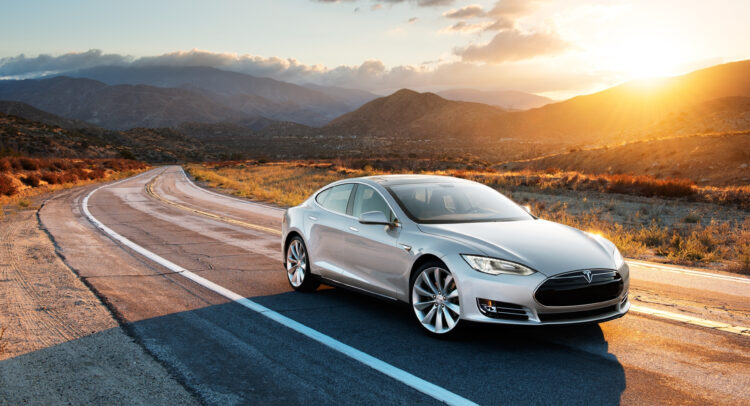As rightly anticipated in my last Tesla (NASDAQ:TSLA) article from March, the stock is down by 13% over the past month. Aggressive price cuts made by Tesla have clearly frustrated the investing community. They fear that more price cuts could be coming, further eroding Tesla’s industry-leading margins.
Claim 50% Off TipRanks Premium and Invest with Confidence
- Unlock hedge-fund level data and powerful investing tools designed to help you make smarter, sharper decisions
- Stay ahead of the market with the latest news and analysis so your portfolio is always positioned for maximum potential
Tesla stock lost another 10% after it announced lackluster Q1 results on April 19, with a 24% decline in the company’s profits. Both Q1 earnings and revenue metrics fell slightly short of analysts’ expectations. Also, not just earnings and revenues but free cash flow also fell massively from $1.42 billion in the preceding quarter to $441 million in Q1. Given the uncertainties surrounding TSLA stock, I will remain on the sidelines. Nonetheless, let’s dive in.
More Price Cuts Could Cause a Price War and Industry Consolidation
Ahead of its Q1 results, TSLA took the bold step of cutting prices on its EVs (electric vehicles) one more time. The latest price cuts mark the sixth time since the beginning of 2023. Currently, Tesla produces four EV models — the Model 3, S, X, and Y.
The EV maker cut the U.S. prices of its Model 3 by $2,000 to $39,990 and Model Y vehicles by $3,000. In fact, now selling at $46,990, the cheapest version of the Model Y SUV is lower priced than the average car or truck currently selling in the U.S. This is very surprising, especially given the fact that the Model Y was rated as the top-selling EV in the U.S. in 2022. In addition, its base Model 3 sells for less than $40,000 compared to $62,990 at the end of 2022.
Auto industry stalwarts like Ford Motor (NYSE:F) fear that an EV price war is impending based on the aggressive price cuts made by Tesla on its top-selling models. Other EV makers have also made price cuts, and if a price war happens, it will squeeze the margins for EV companies.
In a worst-case scenario, several smaller players may be forced to exit the industry due to the magnitude of higher costs and growing losses, especially given ongoing macro challenges. Notably, Tesla is the only profit-making EV company at present, while other EV players are yet to be break-even. Tesla’s cost advantage could help it gain market share as smaller players exit the market and the industry consolidates.
Tesla Chooses Higher Volumes Over Higher Margins
In a tough market environment where demand is waning due to a host of factors, Tesla is choosing to prioritize higher volumes over higher margins. Justifying his price-cutting actions, Tesla’s CEO Elon Musk stated during the earnings call, “Pushing for higher volumes and a larger fleet is the right choice here versus a lower volume and higher margin. However, we expect our vehicles, over time, will be able to generate significant profit through autonomy.”
Price cuts did help lift vehicle sales. Despite waning demand for cars, Tesla beat delivery expectations in Q1 with 422,875 cars delivered, growing 36% year-over-year and about 17,000 more than the prior quarter.
There’s a growing fear among the investor community that further price cuts will lead to a significant compression of Tesla’s industry-leading margins. For instance, Tesla’s Q1 gross margins (excluding regulatory credits) fell to 16% compared to 21% in the preceding quarter. Likewise, its Q1 operating margin fell to 11.4% from 19.2% in the year-ago quarter. However, it’s important to note that Tesla’s operating margins are still way ahead of peers like Ford and GM, with operating margins around the mid-single digits.
Besides price cuts, there were a number of other reasons cited by management for lower margins, including underutilized factories and increased raw material, commodity, and other costs.
Still, Tesla management remains confident in achieving 20% gross margins in FY23 based on resilient demand and deliveries. Investors, however, are worrisome about the margin profile of the company in the coming years at the rate that it has been slashing its vehicle prices recently.
Analysts are dissuaded too. Following the Q1 results, TSLA stock was hammered due to multiple downgrades from several Wall Street analysts.
Is TSLA Stock a Buy, According to Analysts?
As per TipRanks, the average Tesla stock price forecast of $201.70 implies 22.8% upside potential. Wall Street analysts are cautiously optimistic about TSLA stock and have a Moderate Buy consensus rating based on 15 Buys, 13 Holds, and four Sells.

TSLA is trading at a P/E ratio of 41.6x, a significant premium to the peer group median (11.8x). However, it’s trading at a lower multiple compared to its own five-year average of 175x.
Conclusion: Remain on the Sidelines Until “Stormy Weather” Subsides
As cited during the call, Musk is bearish on the macro environment, expecting the “stormy weather” to last for the coming 12 months. My opinion doesn’t differ from his. Potentially, further hikes in interest rates will make cars more expensive for consumers, thereby impacting vehicle demand.
Moreover, price cuts by Tesla, if any, may keep the deliveries strong but will squeeze margins further. Also, the long-term demand growth potential for EVs remains attractive, but competition has increased too. Therefore, I believe that Tesla stock will see lower short-term demand and profits, leading to lower stock price levels in the coming months. As a result, I will remain on the sidelines until better visibility arises regarding its long-term demand and profitability profile.
















